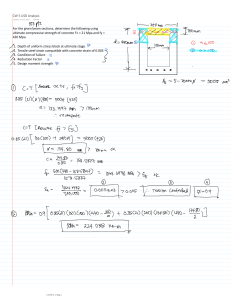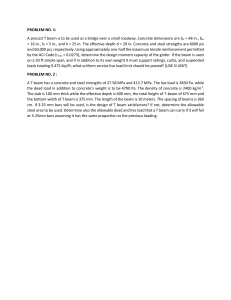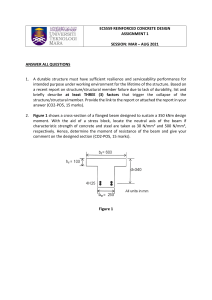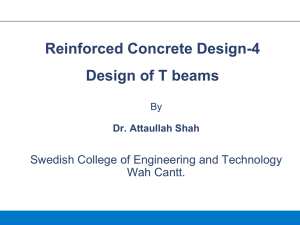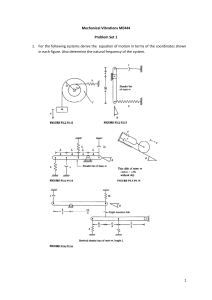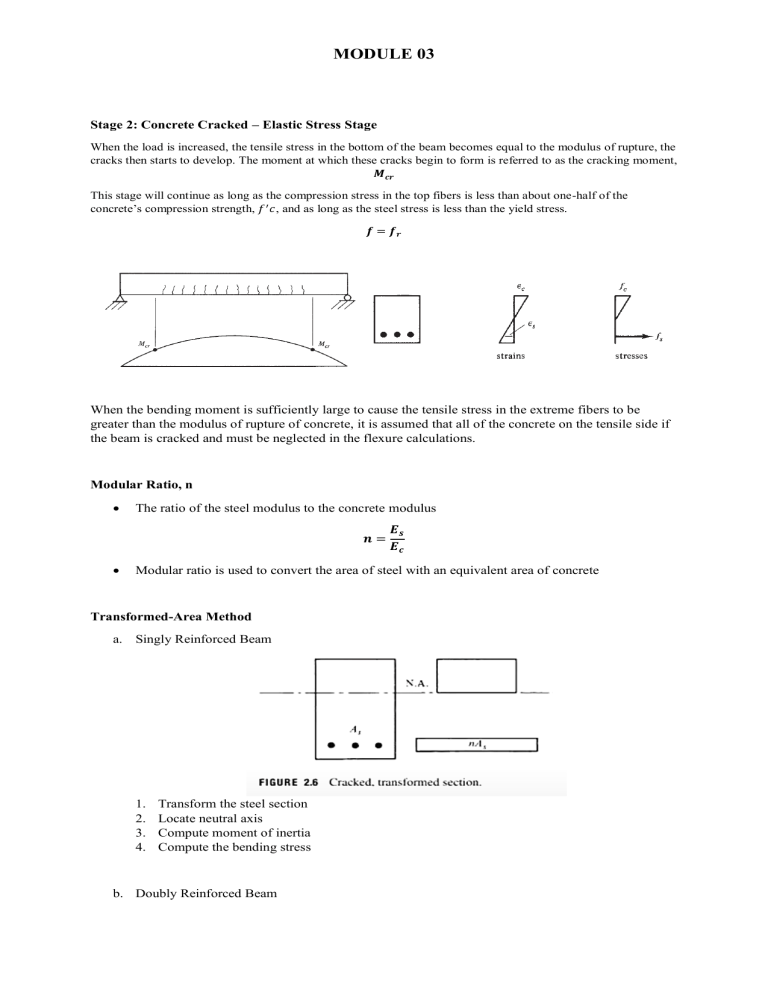
MODULE 03 Stage 2: Concrete Cracked – Elastic Stress Stage When the load is increased, the tensile stress in the bottom of the beam becomes equal to the modulus of rupture, the cracks then starts to develop. The moment at which these cracks begin to form is referred to as the cracking moment, 𝑴𝒄𝒓 This stage will continue as long as the compression stress in the top fibers is less than about one-half of the concrete’s compression strength, 𝑓 ′ 𝑐, and as long as the steel stress is less than the yield stress. 𝒇 = 𝒇𝒓 When the bending moment is sufficiently large to cause the tensile stress in the extreme fibers to be greater than the modulus of rupture of concrete, it is assumed that all of the concrete on the tensile side if the beam is cracked and must be neglected in the flexure calculations. Modular Ratio, n The ratio of the steel modulus to the concrete modulus 𝒏= 𝑬𝒔 𝑬𝒄 Modular ratio is used to convert the area of steel with an equivalent area of concrete Transformed-Area Method a. Singly Reinforced Beam 1. 2. 3. 4. Transform the steel section Locate neutral axis Compute moment of inertia Compute the bending stress b. Doubly Reinforced Beam Double reinforced beam is a beam that has compression steel as well as tensile steel. Compression steel is generally thought to be uneconomical, but occasionally its use is quite advantageous. Compression steel will permit the use of appreciable smaller beams than those that make use of tensile steel only. Reduced sizes can be very important where space or architectural requirements limit the sizes of the beams As a consequence if creep in the concrete, the stresses in the compression bars computed by the transformed area method are assumed to double as time goes by. The transformed area of the compression side equals the gross compression area of the concrete plus 2nA’s minus the area of the holes in the concrete (1A’s), which theoretically should not have been included in the concrete part Sample Problem 1 a. Compute the bending stress in the beam, in MPa, shown in the figure by using the transformedarea method, f’c = 20.7 MPa, n = 9 and M = 94,90 kN-m b. Determine the allowable resisting moment of the beam, in kN-m, if the allowable stress are fc = 9.30 MPa and fs = 137.90 MPa. 𝜋𝑑2 ) (3) 4 𝜋(28)2 𝐴𝑠 = ( ) (3) 4 𝑨𝒔 = 𝟏𝟖𝟒𝟕. 𝟐𝟔 𝒎𝒎𝟐 𝐴𝑠 = ( 𝒏𝑨𝒔 = 𝟏𝟔, 𝟔𝟐𝟓. 𝟑𝟏 𝒎𝒎𝟐 𝑥 𝐴𝑐 ( ) = 𝑛𝐴𝑠 (435 − 𝑥) 2 𝑥 305(𝑥) ( ) = (16,625.31)(435 − 𝑥) 2 𝒙 = 𝟏𝟔𝟗. 𝟗𝟖 𝒎𝒎 𝐼𝑔 = 𝐼𝑔𝑐 + 𝐼𝑔𝑠 𝐼𝑔𝑐 = 𝑏ℎ3 3 (305)(169.98)3 3 𝑰𝒈𝒄 = 𝟒𝟗𝟗. 𝟑𝟏𝟐 𝒙𝟏𝟎𝟔𝒎𝒎𝟒 𝐼𝑔𝑐 = 𝐼𝑔𝑠 = 𝐴𝑑2 𝐼𝑔𝑠 = 16,625.31 (265.02)2 𝑰𝒈𝒔 = 𝟏, 𝟏𝟔𝟕. 𝟔𝟖𝟗 𝒙𝟏𝟎𝟔𝒎𝒎𝟒 𝑰𝒈 = 𝟏, 𝟔𝟔𝟕. 𝟎𝟎𝟏 𝒙𝟏𝟎𝟔 𝒎𝒎𝟒 Bending Stress 𝑀𝑦 𝐼𝑔 (94.90𝑥106 𝑁. 𝑚𝑚)(169.98𝑚𝑚) 𝑓𝑐 = 1,667.001𝑥106 𝑚𝑚4 𝒇𝒄 = 𝟗. 𝟔𝟕𝟕 𝑴𝒑𝒂 𝑓𝑐 = 𝑛𝑀𝑦 𝐼𝑔 (9)(94.90𝑥106 𝑁. 𝑚𝑚)(265.02𝑚𝑚) 𝑓𝑠 = 1,667.001𝑥106 𝑚𝑚4 𝒇𝒔 = 𝟏𝟑𝟓. 𝟕𝟖 𝑴𝑷𝒂 𝑓𝑠 = Allowable Resisting Moment 𝑀𝑦 𝐼𝑔 𝑀 𝑐 (169.98𝑚𝑚) 9.30 𝑁/𝑚𝑚2 = 1,667.001𝑥106 𝑚𝑚4 𝑴𝒄 = 𝟗𝟏. 𝟐𝟏 𝒌𝑵. 𝒎 𝑓𝑐 = 𝑛𝑀𝑦 𝐼𝑔 (9)(𝑀 𝑠 )(265.02𝑚𝑚) 137.91 𝑁/𝑚𝑚2 = 1,667.001𝑥106 𝑚𝑚4 𝑴𝒔 = 𝟗𝟔. 𝟑𝟖 𝒌𝑵. 𝒎 𝑓𝑠 = 𝑨𝒍𝒍𝒐𝒘𝒂𝒃𝒍𝒆 𝑹𝒆𝒔𝒊𝒔𝒕𝒊𝒏𝒈 𝑴𝒐𝒎𝒆𝒏𝒕, 𝑴 = 𝟗𝟏. 𝟐𝟏 𝒌𝑵. 𝒎 Sample Problem 2 a. Compute the bending stress, in psi, in the beam shown in th figure. Use n = 10 and M = 118 kipft 𝑨′𝒔 = 𝟐. 𝟎𝟎 𝒊𝒏𝟐 𝑨𝒔 = 𝟒. 𝟎𝟎 𝒊𝒏𝟐 (2𝑛 − 1)𝐴′𝑠 = 38.00 𝑖𝑛2 𝑛𝐴𝑠 = 40.00 𝑖𝑛2 𝑁𝑒𝑢𝑡𝑟𝑎𝑙 𝐴𝑥𝑖𝑠, 𝑥 𝑥 𝐴𝑐 ( ) + (2𝑛 − 1)𝐴′𝑠 (𝑥 − 2.5) = 𝑛𝐴𝑠 (17.5 − 𝑥) 2 𝑥 14 (𝑥) ( ) + 38(𝑥 − 2.5) = 40(17.5 − 𝑥) 2 𝒙 = 𝟔. 𝟒𝟓𝟒 𝒊𝒏 𝑀𝑜𝑚𝑒𝑛𝑡 𝑜𝑓 𝐼𝑛𝑒𝑟𝑡𝑖𝑎 ′ +𝐼 𝐼𝑔 = 𝐼𝑔𝑐 + 𝐼𝑔𝑠 𝑔𝑠 𝐼𝑔𝑐 = 𝑏ℎ3 (14)(6.454)3 = = 1254.60 𝑖𝑛4 3 3 𝐼𝑔𝑠′ = 𝐴𝑑2 = 38(3.954)2 = 594.11 𝑖𝑛4 𝐼𝑔𝑠 = 𝐴𝑑2 = 40 (11.046)2 = 4880.56 𝑖𝑛4 𝑰𝒈 = 𝟔𝟕𝟐𝟗. 𝟐𝟕 𝒊𝒏𝟒 Bending Stress 𝑀𝑦 𝐼𝑔 1000𝑙𝑏 12𝑖𝑛 𝑀 = 118 𝑘𝑖𝑝. 𝑓𝑡 𝑥 𝑥 = 1,416,000 𝑙𝑏 − 𝑖𝑛 1𝑘𝑖𝑝 1𝑓𝑡 𝑓𝑐 = (1416000)(6.454) 6729.27 𝒇𝒄 = 𝟏, 𝟑𝟓𝟖. 𝟎𝟖 𝒑𝒔𝒊 𝑓𝑐 = 2𝑛𝑀𝑦 𝐼𝑔 2(10)(1416000)(3.954) 137.91 𝑁/𝑚𝑚2 = 6729.27 𝒇𝒔′ = 𝟏𝟔, 𝟔𝟒𝟎. 𝟑𝟑 𝒑𝒔𝒊 𝑛𝑀𝑦 𝑓𝑠 = 𝐼𝑔 (10)(1,416,000)(11.046𝑚𝑚) 𝑓𝑠 = 6729.27 𝒇𝒔 = 𝟐𝟑, 𝟐𝟒𝟑. 𝟒𝟒 𝒑𝒔𝒊 𝑓𝑠′ = Exercise Problem 1. A reinforced concrete beam 300 mm wide has an effective depth of 600 mm. It is reinforced with 4-32 mm diameter bars for tension. f’c = 21 MPa and fy = 275 MPa. Find the moment capacity of the beam. 2. A 300 mm × 600 mm reinforced concrete beam section is reinforced with 4 - 28-mmdiameter tension steel at d = 536 mm and 2 - 28-mm-diameter compression steel at d' = 64 mm. The section is subjected to a bending moment of 150 kN·m. Use n = 9. a) Find the maximum stress in concrete. b) Determine the stress in the compression steel. c) Calculate the stress in the tension steel.

